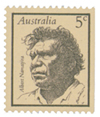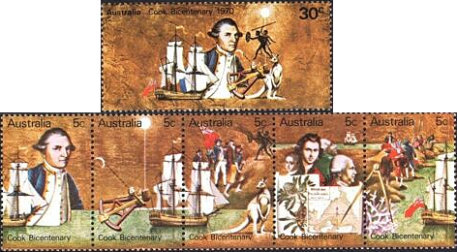History
Timeline results for
Found 1169 results for your search. Showing page 15 of 59.
1968
-
Geologist Jim Bowler discovers the remains of an Aboriginal woman in a dry lake bed of the Willandra Lakes World Heritage area in NSW. The remains are dated to be 40,000 years old and change the view of human history. They reveal a sophisticated culture and are the oldest evidence of homo sapiens outside Africa. The remains are later nicknamed "Mungo Lady".
-

Stamp celebrating Aboriginal artist Albert Namatjira. First named Aboriginal person honoured on an Australian stamp. Artist Albert Namatjira appears on the Famous Australians issue. He was also the first Aboriginal person to be accepted as a citizen of the Commonwealth in 1957.
1969
-
The federal government establishes the National Aboriginal Sports Foundation to help finance sports activities.
-
An Aboriginal delegation goes to New York and presents a statement on Australian Aboriginal people to the office of the UN Secretary-General.
-
The New South Wales Aboriginal Welfare Board is abolished. The trust accounts are closed down and the remaining funds transferred to the Department of Youth and Community Services.
-
Aborigines Welfare Board in NSW is abolished. By 1969 all states have repealed the legislation allowing for the removal of Aboriginal children under the policy of ‘protection’. In the following years, Aboriginal and Islander Child Care Agencies (AICCAs) are set up to contest removal applications and provide alternatives to the removal of Indigenous children from their families.
-
Aborigines Advisory Council set up.
-
Palawa man Andrew David Kennedy is elected as a Labor member to the Australian House of Representatives in the by-election for the seat of Bendigo. He holds the seat until his defeat at the 1972 federal election. Kennedy’s First Nations heritage was unknown when he entered parliament nor did he self-identify as Aboriginal at that time. For these reasons Neville Bonner is recorded as the first Aboriginal parliamentarian (in 1971). [1]
1970
-
Some people from Maningrida in the Northern Territory returned to a preferred traditional way of life on their home estates. These estates were called ‘outstations’ and later ‘homeland centres’. By 1972 many people had moved back to their traditional homelands.
-
Aboriginal Medical Service formed in Redfern, Sydney.
-
Limited land lease rights are given to Aboriginal people on Northern Territory reserves.
-
In the 1970s, the Moree Boomerangs re-emerge after 30 years of abstinence from the rugby league. They can trace their playing days back to the 1940s. The team has included the likes of Phil Duke, Paul Roberts, Ewan McGrady, Dennis Kinchela and Mark Wright.
-
A stamp issue for Australia's 200th anniversary of "first European contact" at the east coast centres around Captain Cook. A mini sheet issued by Australia Post annotates the third stamp of the series (which shows Aboriginal people in the top right corner) with "where he finds new people and strange animals", conveniently omitting conflict.

The Bicentenary issue put Aboriginal people into the far background. Can you spot them?
1971
-
Principals of schools in New South Wales are no longer able to exclude Aboriginal children because of home conditions or community opposition.
-
The Second NSW Teachers Federation Survey finds that 27% of Aboriginal students now reach Year 10 and classifies 38% as ‘Slow learners’.
-
Dennis Walker and Sam Watson open the first and only ever Australian chapter of the Black Panther Party (an anti-racism left wing US organisation) in Brisbane. They monitor police activity and the amount of young black men vs. young white men taken into the prison system for the same crime. The party ceased in 1973. [2]
We followed Aboriginal defendants through – recording and comparing the sentencing trends so we could show that Aboriginal people were the most overarrested and overincarcerated people in the entire Australian community.
— Sam Watson, Aboriginal activist [2] -
Aboriginal flag is designed by Luritja artist Harold Thomas and flown for the first time in Adelaide.
-
Evonne Cawley, an Aboriginal tennis player, receives the Australian of the Year award. ⇒ Famous Aboriginal people
-
Aboriginal workers walk off the Noonkanbah cattle and sheep station in Western Australia to stop oil drilling on a sacred site.
-
Gumatj Elders Millrrpum and others take on Nabalco Pty Ltd and the federal government in the Gove land rights case following on from the Bark Petition. The Northern Territory Supreme Court ruled that Aboriginal people did not, under Australian law own the Arnhem Land reserve. This meant Nabalco could mine bauxite from the land.
References
View article sources (2)
[1]
'Indigenous Australian parliamentarians in federal and state/territory parliaments: a quick guide', Parliament of Australia 15/6/2021, available at www.aph.gov.au/About_Parliament/Parliamentary_Departments/Parliamentary_Library/pubs/rp/rp2021/Quick_Guides/IndigenousParliamentarians2021
[2]
[2a]
'The Black Panthers Brisbane Chapter', Hell Yeah Magazine, 3rd edition, 2011 p.31

